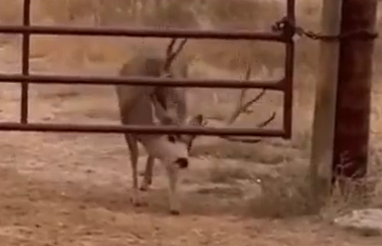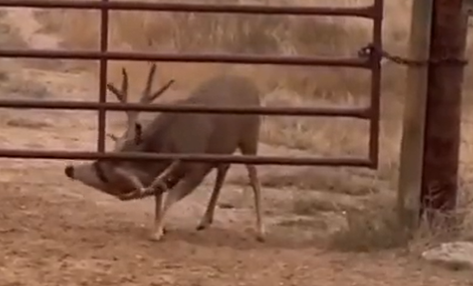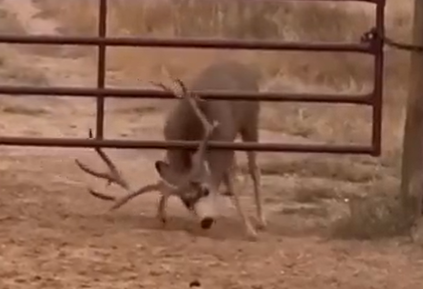I was already mulling this topic when, this morning, a video of a deer popped up on my twitter feed.
The video shows a buck maneuver his rack so he can get under a gate.
Here’s four screen grabs so you can see how he did it.




It’s striking, isn’t it?
But to my eye, this maneuver also demonstrates something profound about reality and about how we think.
It embodies a type of thinking.
Literally.
We think with our bodies.
Notice how we respond to this video of the deer by saying “clever deer” or “smart animal.” That’s a tell. We recognize that what we’re seeing is a kind of thought, a kind of intelligence.
The deer has “figured something out.” It’s “solved a problem.”
I also believe that many of us human beings, over the past 2-3 generations, have lost skills that allow us to think the way this deer thinks.
We over-emphasize abstract thinking–and that’s a mistake.
It starts in childhood.
This is the topic Joseph Chilton Pearce tackled in his book Magical Child. He argues that for a child to develop into a happy, well-adjusted adult, the child needs to be allowed to bodily explore 3D reality up to around age seven:
Structuring a knowledge of the world takes at least six years because the world is filled with many things and its processes and principles are strict. The child is programmed to interact with the actual world: a place of rocks, trees, grass, bugs, sun, moon, clouds, rain, snow, and a million things; a world that runs on principles, where cause and effect balance, where “fall down go, go boom” means skinned knees, where fire burns and hot means don’t touch.
So what happens when we force so-called “literacy” on children under the age of seven or so?
Pearce warns that we damage them. They become anxious. They fail to internalize a certain, irreplaceable sense of trust in the world.
Imagine if that deer had not practiced, as a fawn, maneuvering its body around trees and branches and possibly even fence gates.
It wouldn’t have grown up into such a smart deer.
Therefore, if it had tried to get under the gate, it might have gotten its antlers tangled.
That could easily be fatal to the deer.
The deer would be justified in believing, in its deer-mind, that it’s dangerous to try to get under a gate.
I’ve observed this personally: when we yank kids out of the physical world too early, they never fully gain the ability to think with their bodies.
It’s so obvious, it’s a cliché. The little kid who always has his nose in a book grows up to be the teen who isn’t “good at sports.” He’ll tend to be more timid (so goes the cliché) and clumsy.
Clumsiness is literally not knowing where your body is in space, relative to other objects.
We accept this as inevitable. We laugh at it. We tell ourselves that we value the clumsy smart kid “just as he is.”
We tell ourselves that it’s unlikely our clumsy smart kid will ever face a situation where a body sense of how to respond might mean the difference between life and death.
Which has been true, for the past few decades, in most parts of the world.
Do you trust that it’s still true?
I don’t.
And even if our kids are physically safe, look at their mental health.
It’s terrible.
And how much can we attribute modern “anxiety” to an educational system that over-emphasizes “literacy” and abstraction?
We think we’re doing the right thing when push “literacy” on kids who are two, three, four years old.
What if that’s an enormous mistake?
Pearce argues that when children are allowed to fully explore 3D reality, they learn to trust it and by extension to trust themselves.
That makes a ton of sense to me.
Now consider how different people respond to “threats” — for example, reports of worldwide outbreaks of a viral infection.
There are clear categories in the way people respond.
Some people turn to their own bodies and to “nature.” “Natural immunity.” Herbs, supplements, “home remedies.” Objects they can personally manipulate and control.
Other people vehemently reject that we should trust any of that stuff. They turn to abstractions. They want “public health officials” to enact “policies” to “modify behavior” and “enforce x public health programs.”
The Abstraction Ones believe that if we find the correct abstract response, it will serve to mediate the threat and keep them safe.
In both cases, peoples’ response is visceral. It emerges from an inner knowing, not from an external argument, not from “data.”
The external arguments and data come afterward; we use them to justify what we already know to be true.
We like to tell ourselves our responses are logical and based on data, but what’s most important is our starting point.
“I trust my body’s immune system.”
“The right public policy will save me.”
Those are mental models.
We grab the model that feels right because it is already real to us, not because one or the other is inherently correct.
But here’s the problem. The Abstraction Ones (just as Pearce predicted) tend to be more anxious.
This makes sense. If you rely on “something out there” that you can’t see or touch or control to keep you safe, you’re going to be anxious.
If you can soothe yourself by reaching for that bottle of Vitamin D, you’re going to be less anxious.
If you’re the deer standing by the gate, wondering if a government-mandated Gate Opening Agency is going to show up and let you through before the coyotes find you, you’re going to have some anxious moments.
The 1980s is when we began pushing, universally, for kids to start “learning to read” at pre-K ages.
We’re now dealing with an epidemic of anxiety-related issues among our younger generations.
I don’t believe that is a coincidence.
We’re wiring kids’ brains differently.
The new wiring does NOT equip people for life.
